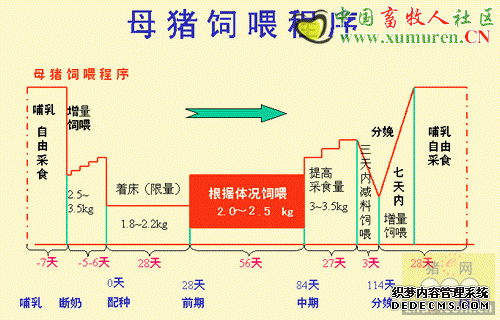Feed Intake - A Checklist of Nutritional, Environmental and Management Strategies to Achieve Success
Whereas data obtained under such conditions provides some indication of how various factors influence voluntary FI in pigs, it is often difficult to extend such information to commercial production systems. This is particularly so considering that in a typical commercial farm, several factors occur simultaneously and interact with each other to determine overall voluntary FI levels.
Some of these factors are under study at the Prairie Swine Centre, and additional studies,particularly with large groups, will be conducted at the new research Centre at Elstow,Saskatchewan to be opened in March 2000.
This presentation provides an overview of the various factors that have been shown to affect voluntary FI, growth performance, and carcass characteristics in pigs and identifies some key areas where management can improve feed intake, particularly in grower-finisher pigs.
Factors Affecting Feed Intake in Pigs
Various factors have been shown to influence FI in pigs. This includes such factors as theenvironment (temperature, humidity, heat radiation, and air circulation), social factors (stocking density, group size, regrouping, etc.), genetics, health status, feeding frequency, dietary nutrient density, and presentation of food.
ENVIRONMENTAL FACTORS
Temperature
Air temperature is the most studied environmental factor with respect to its impact on animalperformance. Animals perform well within a certain temperature range referred to as thethermal neutral zone (or comfort zone). This range for growing pigs is within 12-23oC,temperatures above this decrease feed intake, while temperatures below this range increasefeed intake. Under high temperatures, feed intake is reduced approximately 40 grams for every1oC above the thermal neutral zone. The problem of heat stress on pigs increases withbodyweight: each degree above thermal neutral zone reduces intake by 1% for 20kg pigs and2.5% for 100kg pigs. Although we understand how this will slow growth rate, the impact onbody composition has not been determined for pigs raised under hot conditions.
The effects of cold stress have not been studied extensively. Pigs exposed to cold stress havea higher metabolic rate resulting in increased feed intake, and a reduction in feed efficiency andgain. The extra feed consumed for each 1oC below lower critical temperature has beenestimated at 25 and 39 g per day for growing pigs and finishing pigs respectively, while averagedaily gain (ADG) is reduced by 10-22 g/d. These estimates are likely to be lower for pigshoused in larger groups. Pigs tend to become fatter under cold stress, while some researchershave also reported decreased protein deposition in the carcass. Practical experience of porkproducers using shelter housing in winter would substantiate the suggestion that index fallsunder cold conditions, especially when large amounts of bedding are not available to allow thepig to regulate its thermal environment.
Recent studies at the Centre conducted by Dr. Lemay indicate that both feed intake and gaincan be improved by approximately 6% when a summer strategy of lowering the setpointtemperature is followed. The research suggests that producers can offset the impact of lowfeed intake and gains associated with rising summer temperatures. By adjusting the lowersetpoint temperature 6 oC below standard for the summer period, cool evening air can be usedto lower room temperatures (observed about 2oC) and increase feeding activity over theevening hours to compensate for reduced feed consumption during the day.
Humidity and Ventilation Rates
The impact of relative humidity on swine performance is tied to the prevailing temperature andventilation rate. The effect of high humidity on FI, ADG, and FE is more pronounced duringperiods of high rather than low ambient temperature. In a study with growing-finishing pigs (25to 106 kg), average daily FI was significantly reduced when temperature was increased to 28癈at a relative humidity of 65 ?70%, the typical relative humidity in commercial barns. In the samestudy, increasing relative humidity from 45 to 90 % at a constant air temperature of 24癈 causeda significant reduction in FI and ADG. High humidity severely minimizes the ability of pigs underheat stress to dissipate the extra body heat through evaporation.
Ventilation rate determines the effective temperature that the animal actually feels. Thus humidconditions combined with high airspeeds can create uncomfortably low temperatures for theanimal although the thermostat setting may appear accurate. These conditions lead toincreasing feed intake. Low ventilation rates leads to increased CO2 levels and microbialproliferation and this adversely impacts on FI and ADG.
SOCIAL FACTORS
Space Allocation
Space restriction in pigs causes significant reductions in FI and ADG compared to adequatespace allowed pigs (Table 2). Although space restriction causes reductions in FI and ADG inpigs, the magnitude of response relative to the level of restriction is quite variable. For instance,in one study a 36.7 % reduction in space allowance for 18-55 kg pigs reduced FI and ADG by11 and 18 %, respectively while a 50 % space reduction for young pigs (7.1-19.6 kg) reducedboth FI and ADG by approximately 12 %. At Prairie Swine Centre, Dr. Harold Gonyou usinggrow-finish pigs subjected to crowded conditions (approx. 24% space reduction) discovered thatboth feed intake and ADG were reduced.
声明
来源:互联网
本文地址:http://farm.00-net.com/yz/zhu/5/2007-09-20/142401.html








